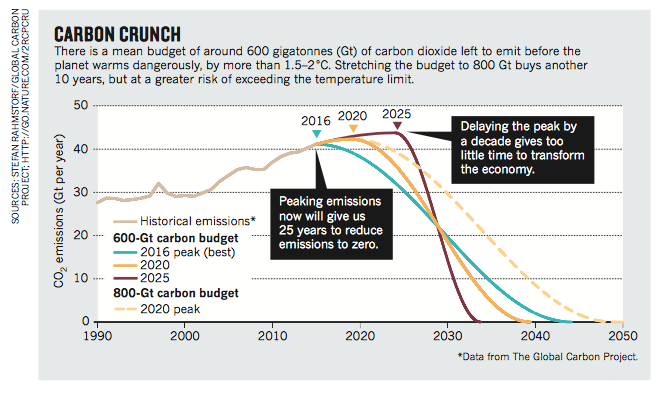Christiana Figueres (former UN climate Chief) and colleagues set out a six-point plan for turning the tide of the world’s carbon dioxide by 2020.
In the past three years, global emissions of carbon dioxide from the burning of fossil fuels have levelled after rising for decades.
This is a sign that policies and investments in climate mitigation are starting to pay off. The United States, China and other nations are replacing coal with natural gas and boosting renewable energy sources. There is almost unanimous international agreement that the risks of abandoning the planet to climate change are too great to ignore.
The article is written by experts from: The Global Covenant of Mayors for Climate and Energy, The Potsdam Institute for Climate Impact Research (Germany), The Pentland Centre for Sustainability in Business (Lancaster University, UK), The Stockholm Resilience Centre(Stockholm University, Sweden), Carbon Tracker (London, UK) and The Earth system analysis at the Potsdam Institute for Climate Impact Research (Germany).
The exerts point out that it is still possible to meet the Paris emissions agreement IF emissions start to fall by 2020, which means global temperatures will likely avoid reaching an irreversible threshold. Impacts would include rapid deforestation, floods from rising sea levels, and unpredictable weather shifts that could ravage agriculture and affect life on the coasts, where the vast majority of people live.
They wrote that, after subtracting past emissions, humanity is left with a ‘carbon credit’ of between 150 and 1,050 gigatonnes (Gt; one Gt is 1 × 109 tonnes) of CO2 to meet the Paris target of 1.5 °C or well below 2 °C (see go.nature.com/2rytztf ). The wide range reflects different ways of calculating the budgets using the most recent figures. At the current emission rate of 41 Gt of CO2 per year, the lower limit of this range would be crossed in 4 years, and the mid- point of 600 Gt of CO2 would be passed in 15 years. If the current rate of annual emissions stays at this level, we would have to drop them almost immediately to zero once we exhaust the budget. Such a ‘jump to dis- tress’ is in no one’s interest. A more gradual descent would allow the global economy time to adapt smoothly.

In the article, the researchers state that the fossil-free economy is already profitable and that it could even unlock $13.5 trillion by 2050. Furthermore, the researchers prioritized actions, by identifying milestones in six sectors. Developed with knowledge leaders, these were reviewed and refined in collaboration with analysts at Yale University, the Climate Action Tracker con- sortium, Carbon Tracker, the low-carbon coalition We Mean Business, the Partner- ship on Sustainable, Low Carbon Transport (SLoCaT), advisory firm SYSTEMIQ, the New Climate Economy project and Con- servation International.
Their plan includes six goals for 2020:
Increase renewable energy to 30% of electricity use.
Draft plans for cities and states to ditch fossil fuel energy by 2050, with funding of $300 billion annually.
Ensure 15% of all new vehicles sold are electric.
Cut net emissions from deforestation.
Publish plan for halving emissions from deforestation well before 2050.
Encourage the financial sector to issue more “green bonds” toward climate-mitigation efforts.
The authors call for cities and businesses to fight emissions and meet the Paris accord goals, even without the help of the US government.
“These goals may be idealistic at best, unrealistic at worst. However, we are in the age of exponential transformation and think that such a focus will unleash ingenuity. By 2020.”
Read the full article and more about the 6 milestones here
